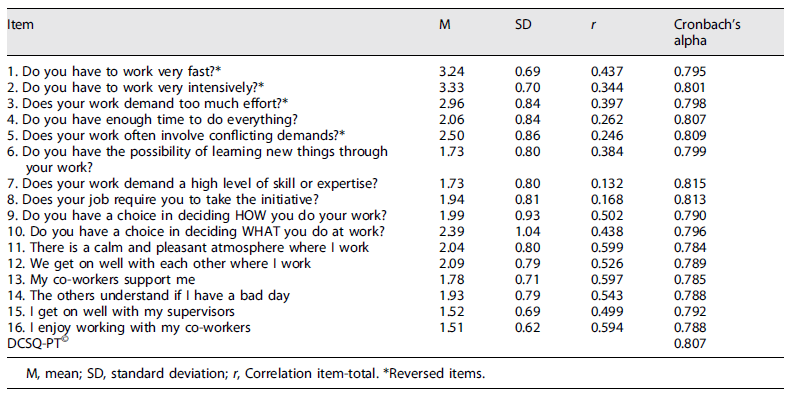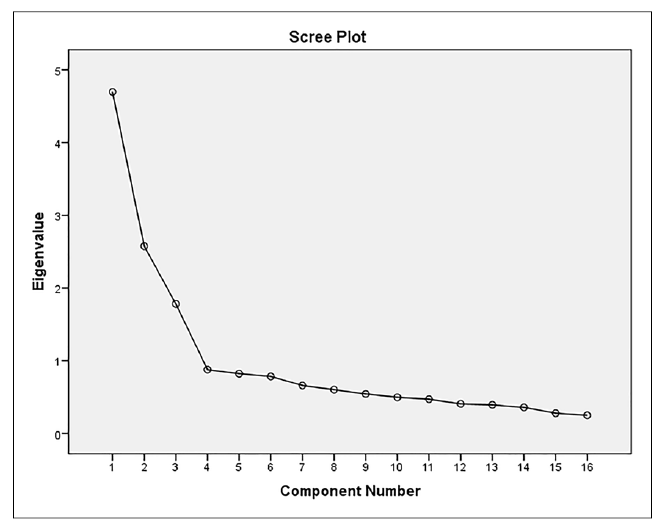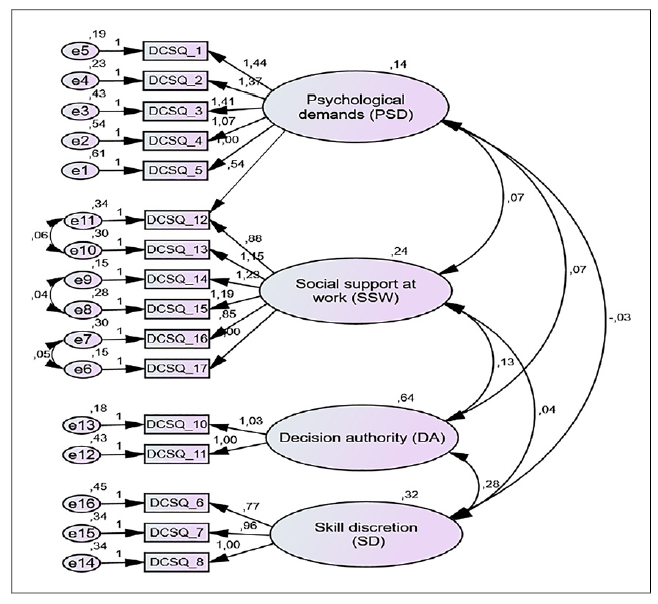Background
Community health is fundamental to a country’s social and economic development, with workers being an essential part of the population. There are work-related psychosocial risks in organizations that may have a detrimental impact on employees’ physical, psychological, and social health. Psychosocial risk factors include job control, work schedules, work overload, interpersonal relationships, and organizational culture 1.
The way in which work is organized and the interaction between the demand level and the control level are the focus of the demand-control model. This model has been widely used in research into the effect of job strain and its implications for health. The combination of high psychological job demands and a lack of control by workers in performing their tasks generate job strain 2. This is usually measured by the Job Content Questionnaire (JCQ) 3 and is associated with a higher risk of inactivity 4, an increased risk of cardiovascular disease 5-7, and an increased risk of clinical depression 8.
A study conducted with data from the European Working Conditions Survey collected from 15 countries examined how psychosocial working conditions relevant to health changed from 2005 to 2015. It concluded that stress at work increased, was mainly driven by psychological demands (PSDs), and was higher in people working in less skilled occupations 9.
Consequently, improving the work-health relationship and promoting the well-being of workers are necessary measures for public health and influence society. To this end, performing a work-related psychosocial risk assessment is good practice in promoting workers’ health. Three instruments have already been validated for the Portuguese population that assess the risk factors associated with work and the socio-relational context of work: the Copenhagen Psychosocial Questionnaire (COPSOQ II), the Work Design Questionnaire (WDQ), and the Job Content Questionnaire (JCQ) 10.
COPSOQ II is a multidimensional instrument that assesses the conditions of the work environment and the relationship of work with the life of the worker. It is a complete instrument in which the shortest version has 40 questions, the average version 87, and the long version 128 11.
WDQ is a multidimensional instrument that also assesses areas related to physical risks and comprises 77 items 12. JCQ is a multidimensional tool of 49 items that operationalizes the job demand-control-support model mentioned above 3, but only 22 items from the full version have been selected for translation into Portuguese 13.
However, a short version had earlier been proposed to operationalize the job demand-control-support model; this is the Demand Control Support Questionnaire (DCSQ), which has 17 items distributed among three factors: PSDs with five items, decision latitude with six items, and social support at work (SSW) with 6 items 14,15. This questionnaire was revised in two Brazilian studies, and the decision latitude factor, as in previous studies, was subdivided into skill discretion (SD) and decision authority (DA) 15,16. For the SD factor, the item repetitive work was excluded. Job decision latitude is a combination of two empirically related, but theoretically distinct constructs: the worker’s freedom to make decisions (DA), and the spread of skills that the worker uses on the job (SD) 15. The final model showed acceptable levels of internal consistency, except for the PSDs factor in which a correlated measurement error between work fast and work intensively was observed 15.
A representative sample of the Swedish working population was used in a study designed to examine the measurement invariance of the multi-dimensional factor structure of DCSQ. The study confirmed the existence of four factors, after splitting decision latitude into SD and DA. The recommendation was that the item repetitive work be removed from SD 16. This model of the DCSQ has been validated in various languages but has yet to be validated in European Portuguese.
A short version of a referenced model for assessing work-related psychosocial risks could be very useful in monitoring workers’ health because the constantly evolving world of work requires periodic assessments of psychosocial risks. The aims of this study were therefore to adapt, examine the factor structure of, and determine the reliability of, the Demand Control Support Questionnaire (DCSQ) short version for European Portuguese.
Methods
An observational study was conducted in accordance with the STROBE statement for observational studies 17.
Sample
Due to the restrictions imposed by COVID, an online convenience sampling survey was conducted from November 2020 to July 2021. However, in this online survey, and particularly because of ethical concerns, the following were taken into consideration: informed consent, the anonymity of the participants and the confidentiality of the data. The survey was designed using www.googleforms.com. To avoid duplications or fraud, respondents were required to pass a CAPTCHA test, and cookies were used to detect multiple submissions.
Workers from various professional sectors were invited to access a link to respond to the online questionnaire sent by email. Participants accessed the link to the online questionnaire using institutional mailing lists sent by the communication office of the institutions that joined the study.
Participants were asked to return the questionnaire within 2 weeks. Only adult men and women (aged ≥18 years) of Portuguese nationality were recruited.
The necessary sample size to perform factor analysis was calculated based on the rule of thumb of 10 participants per item in the DCSQ 18. The instrument included 16 items that could be validated, and hence the number of participants required was 16*10 = 160. Within 9 months of survey activation (2 weeks in each institution), 530 responses were received, of which 29 were deemed incomplete and were excluded. The final sample was 501 participants.
Instruments
Sociodemographic data (sex, age, and education) and professional data (sector of activity) were collected. In the initial stage of the study, after written authorization was given by the author of the job stress questionnaire and permission was obtained to use the English version, the tool was translated into Portuguese. International guidelines relevant to the cross-cultural adaptation process were followed 19,20.
The process included the following steps: preparation, forward-translation, reconciliation, back-translation, back-translation review, expert panel, and pilot testing. Two professional translators translated from English to Portuguese. After the translations were analysed and a consensus version was obtained, two professional English translators performed the back-translation. Following the results for the back-translation, all the versions were harmonized to detect and address any discrepancies that might have arisen between the different language versions, ensuring conceptual equivalence.
Finally, the author of the original instrument reviewed the final version, and adjustments were made after clarification of terminological questions. The clarification was made for two terms: demand (item 4) and conflicting demands (item 5).
Content and face validity were submitted to a Delphi panel of seven bilingual individuals. Each of the seven Delphi panel members gave their opinion on the adequacy of the translation and the relevance of the items 21,22. The experts were from a broad spectrum of disciplines, including two nursing experts, a physician specializing in public health, a psychologist, and two PhD experts in scale validation. The inclusion criteria were a PhD degree, published articles in the area in a reference journal, and clinical practice of at least 1 year in the field. All the experts were also bilingual and were invited by the researchers. In a cover letter, clear instructions were provided to the panel members for how to rate each of the items of the instrument in terms of adequacy and relevance to the underlying construct, using a 4-point ordinal scale. For adequacy, the following scoring system was used: (1) = not adequate, (2) = needs major revision, (3) = needs minor revision, and (4) = very adequate. The scoring for the relevance of the items used a similar ranking: (1) = not relevant, (2) = needs major revision, (3) = needs minor revision, and (4) = highly relevant. A higher score means better items. A table was included with instructions to guide the experts on the scoring method.
The item-level content validity index (I-CVI) was calculated by averaging the seven experts’ ratings to obtain the content validity index for the adequacy and relevance of each item. ICV examines a health measurement instrument’s relevance/adequacy, ease of computation and comprehensibility, and it can be reported for the scale as a whole (S-CVI) and its individual items (I-CVI) 21, 22. The I-CVI of the items ranged between 79%/80% (relevance/adequacy) and 100% (adequacy and relevance). The global S-CVI was 91% (adequacy/relevance), which indicates the high content validity of the items for the DCSQ.
The Portuguese translation was pilot-tested by 50 participants. The time taken to complete the questionnaire ranged from 5 to 10 min. No changes were found to be necessary. After the transcultural adaptation process was completed, the psychometric characteristics of the job stress scale were appraised. The author approved the final version of the scale.
Data Analysis
The data were analysed using SPSS version 28 for Windows (IBM Corp., Armonk, NY, USA). Confirmatory factor analysis was performed using the AMOS v.26 package.
The CVI was calculated for all individual items (I-CVI) and the overall scale (S-CVI). The internal CVIs were rated as good when I-CVI and S-CVI were at least 78% and 80%, respectively 22. If the I-CVI was above 78%, the item was considered appropriate, if it was between 70% and 79%, the item was considered to require revision, and if it was lower than 70%, it was considered to require rewriting. Scale internal content validity (S-CVI) was computed, representing the proportion of all the items that were rated as content valid.
Descriptive data analysis was performed, and the Demand Control Support Questionnaire (DCSQ) (Portuguese version)© (DCSQ-PT©) was validated on the basis of reliability and validity tests 23. Pearson’s correlation and Cronbach’s alpha were calculated for all items of the instrument and the scale to analyse the reliability of the scale.
To analyse the validity of the DCSQ-PT©, confirmatory and exploratory factor analysis was carried out. For the confirmatory factor analysis, several indexes of the global fitness of the factorial model were considered, which were: the ratio of χ2 (χ2) and degrees of freedom (df), presented by the expression χ2/df; the goodness of fit index; the comparative fit index (CFI); the root mean square error of approximation (RMSEA) index; the root mean square residual (RMR) index; and the standardized root mean square residual (SRMR) index.
A factorial model is assumed to have a good global fitness if χ2/df is below 3, goodness of fit index and CFI are above 0.900, and RMSEA, RMR, and SRMR are below 0.050, with values up to 0.100 considered to be acceptable 23. The composite reliability (CR) and the mean-variance extracted were also analysed as indicators of convergent validity.
The discriminating validity of the factors was analysed through a comparison between the mean-variance extracted and the square of their correlations. The multinormality of the Demand Control Support Questionnaire variables was evaluated using the analysis of the asymmetry coefficient and kurtosis 24.
Results
The Sample
The mean age of the sample was 41.8 ± 10.3 years, 50.1% of the participants were female, and 46.11% had finished higher education. Only 11% worked in healthcare settings, while 31.5% worked in the education sector and 57.5% in industry. Statistically significant differences were found between gender and both academic qualifications (χ2 = 59.22; p < 0.001) and the sector in which the employee worked (χ2 = 99.56; p < 0.001). More of the women had higher education and worked in the academic sector, and more of the men worked in industry.
DCSQ-Pt© Psychometric Proprieties
The items showed skewness and kurtosis values of between −2 and +2, which is generally considered acceptable 25. After many analyses (reliability, and confirmatory and exploratory factor analysis), no items were deleted.
Reliability
Regarding the Pearson’s correlation coefficients, it was found that all 16 items in the scale presented correlations above 0.200, except for items 7 (0.149) and 8 (0.190) which were still statistically significant given the sample size 24‒26. Cronbach’s alpha for all items and excluding each time one of the items was calculated to evaluate the reliability of the scale.
The data analysis is presented in Table 1. Cronbach’s alpha of the DCSQ-PT© was found to be 0.807, showing that the scale has good internal consistency 24. Some items with a Cronbach’s alpha above the global internal consistency were maintained due to the theoretical possibilities of interpreting these items. The analyses for each sex were similar.
Factor Structure
With the 16 items, exploratory factor analysis was then developed using the principal components method, with Varimax orthogonal rotation, and forced to four factors, according to the original scale 16. The four factors (Table 2; Fig. 1) explain 62.07% of the total variability. The factors emerging from this analysis coincide with those in the original scale 16.
Table 2 Exploratory factor analysis of the DCSQ-PT©
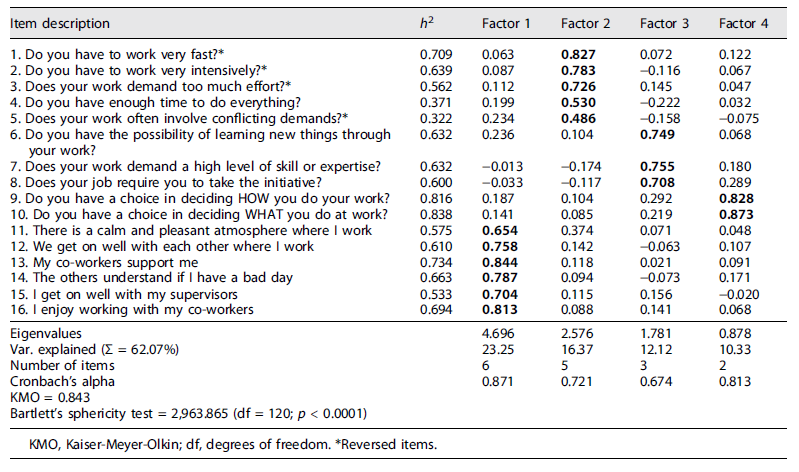
KMO, Kaiser-Meyer-Olkin; df, degrees of freedom.*Reversed items.
Factor 1 was named SSW; factor 2 was made up of six items and was named PSDs; factor 3 was named SD and is made up of three items; and factor 4 was named DA and is made up of two items.
Regarding the reliability of the factors, this proves to be good and reasonable, with Cronbach’s alpha varying from 0.871 for factor 1 to 0.674 for factor 3. It should also be noted that the lowest value of the communalities (h2) is 0.322.
Pearson’s correlation between the various factors and the total scale DCSQ-PT© was also calculated. The correlations are positive and moderate (from 0.454 to 0.794), indicating that they measure related constructs.
This factorial solution was also tested using confirmatory factor analysis, and the initial model was refined according to the modification indexes proposed by the AMOS. Through this procedure, the global adjustment produced fit for global fitness indexes attesting to the factorial validity of the DCSQ-PT scale (Table 3; Fig. 2).
Table 3 Global fitness indexes
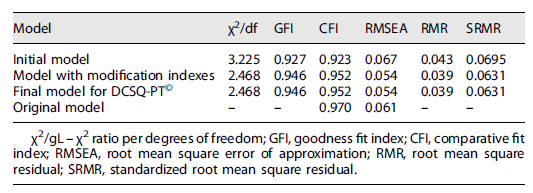
χ2/gL - χ2 ratio per degrees of freedom; GFI, goodness fit index; CFI, comparative fit index; RMSEA, root mean square error of approximation; RMR, root mean square residual; SRMR, standardized root mean square residual.
The CR presents very low values for the factors, but the stratified CR is high, at 0.945 (Table 4). Higher values indicate higher levels of reliability, but values of higher than 0.950 are problematic since they suggest that the indicators are redundant 25. Discriminant validity was found between the factors.
Discussion
By adapting, examining the factor structure of, and determining the reliability of, the short version of the Demand Control Support Questionnaire (DCSQ) into European Portuguese, this study contributes by finding a useful instrument, the DCSQ-PT©, for managing work-related stress in organizations and improving working conditions.
A valid self-assessment scale will enable studies with larger populations, where various evaluations of work-related stress can be studied and compared over time. This scale will also allow the effectiveness of interventions carried out with the aim of reducing work-related stress to be assessed.
The translation of the English version into Portuguese followed international guidelines 18,19. Content validity was obtained with the help of a panel of seven experts through the Delphi technique, getting a level of agreement for each item of 90% that was higher than the 79% considered appropriate by several reference authors 20‒22. These values are similar to those obtained from the validations carried out in other countries. The response time to this instrument varied between 5 and 10 min, a value identical to that found in a study in Spain, a culturally similar country 27.
The psychometric characteristics were determined from a sample of 501 workers. If we analyse other validation studies, we can find similar values regarding age, but not sample size or sex 28,29. Internal consistency tests and exploratory factor analysis were used to determine the psychometric properties, as was done in other studies 28,29, and confirmatory factor analysis was also performed in this study, which again is similar to what was done in the study of the Swedish version of the DCSQ 16.
In the reliability tests for the DCSQ-PT©, it was found that the items showed correlation values with the total scale of more than 0.2, except for items 7 (0.149) and 8 (0.190) 19,21. In the validation study of the German and US English versions of the DCSQ 28, item 7 (skill level) was also the one with the lowest correlation value (−0.38) 27, but this value was higher than in the present study.
Removal of these items would lead to a small improvement in the values of Cronbach’s alpha coefficient values of all items, which were calculated to evaluate the reliability of this scale, in addition to that of the scale, after the exclusion of each item, one by one. Table 1 presents the value that Cronbach’s alpha would take if that particular item was deleted from the scale. We can see that the removal of any item, except items 5, 7, and 8, would result in a lower Cronbach’s alpha. These items were kept in the scale because of their theoretical interpretability. After the exclusion of each item sequentially, the values for Cronbach’s alpha ranged between 0.784 and 0.815, showing good internal consistency 24. The same was true for the total scale, with a Cronbach’s alpha of 0.807. These alpha values are similar to those for the versions of the scales validated in Brazil 15, Japan 29, Sweden 16, and Switzerland 29, and with workers from the USA 28 but have results that demonstrate greater internal consistency.
The DCSQ factorial patterns in several studies 15,28,29 reflected a three-factor solution, but these studies did not use confirmatory factor analysis. The DCSQ version validated in Sweden 16 resulted from a longitudinal study and an exploratory and confirmatory factor analysis and found a four-factor structure with 16 items after the proposed exclusion of the item repetitive work. Based on the model presented in this Swedish study 16, a forced four-factor exploratory factor analysis was performed. The four-factor solution of the present analysis coincides with the model structure 16 in the number of items and their organization. In the resulting model, all items have significantly higher correlation values in the factor where they belong, which confirms the data obtained in studies conducted in other countries.
The Cronbach’s alphas of 0.871 and 0.813 for factors 1 and 4 indicate good reliability, and the Cronbach’s alphas of 0.721 and 0.674 for factors 2 and 3 indicate reasonable reliability, given the number of items. The correlations between the factors and the total scale are positive and moderate, ranging from 0.454 for factor 3 to 0.794 for factor 1. On the original scale, the correlation values were slightly higher, ranging from 0.69 for factor 3 to 0.86 for factor 1 16.
Similarly to the Swedish version of the scale 16, in the confirmatory factor analysis, item 12, “There is a calm and pleasant atmosphere where I work,” is related to two factors: Social Support at Work and Psychological Demands where it has, respectively, loadings of 0.654 and 0.374. The item was left in the factor where it weighed the most, being in line with the original model 16. The RMSEA of 0.054 indicates acceptable values for the four-factor model, as in the model for the Swedish version model that had a value of 0.061 16, and the stratified CR, at 0.945, was very high.
The final DCSQ-PT© model has an adequate fit to the Swedish model, with a CFI value greater than 0.95, and has retained the 16 items from the original version, with a range of scores between 16 and 64 points, with higher scores indicating higher levels of work-related stress. These results suggest an equivalence between the version of the scale culturally adapted for the Portuguese population and the Swedish version. Four factors, PSDs, SD, DA, and SSW, were confirmed by confirmatory factor analysis, with the best fit obtained. It is important to emphasize that, to assess work-related stress, the scale must be used with the 16 items, but that the factor analysis indicates that there are four groups of items that cluster together. Each cluster taps into a different aspect of work-related stress, which can be assessed by the value corresponding to the totality of the items in each factor.
This study has some limitations. First, the analysis is based on cross-sectional data that does not allow the longitudinal stability of the scale to be assessed. Test-retest reliability was not analysed. Second, we did not consider the heterogeneity of the study population with respect to certain job and demographic characteristics. The sample comprises workers from organizations from one region of the country, and almost 50% of the participants had higher education, meaning that it is not possible to generalize the results to the whole Portuguese population. Another limitation was that a non-probabilistic sampling method was used, which inevitably influenced the sample characteristics as the mode of administration and specifically the fact that we used the Internet as a data collection method. However, the study covers workers from different sectors of activity, and in the analysis of the validity of the DCSQ-PT© an exploratory factor analysis was performed, followed by a confirmatory analysis.
The results demonstrate that the Portuguese version of the scale with four factors, as proposed by the authors of 16, presents good reliability and adequate validity. This validation allows an instrument with only 16 items that are clustered into four groups (factor 1: SSW, factor 2: PSDs, factor 3: SD, and factor 4: DA) to be obtained, reflecting the key aspects for the assessment of work-related stress in Portuguese workers.
Conclusions
This study adapts the Demand Control Support Questionnaire for European Portuguese and validates it. The proposed scale provides a conceptual framework for evaluating work-related stress and psychological pressure, such as the time, effort, and speed required to achieve a task. Internal consistency tests and exploratory factor analysis revealed good reliability and adequate validity, similar to those of the original scale and the translations into other languages.
The present study confirms the existence of four correlated dimensions: PSDs, SD, DA, and SSW. Further research should investigate invariance across occupations, socio-economic classes, sex, and age.
Statement of Ethics
The study was conducted following the Declaration of Helsinki, and the protocol was approved by the Ethics Committee of the Institute Polytechnic of Leiria (47/2020). In addition, informed consent was obtained from all participants in all phases. Confidentiality of data was ensured by coding and storage in restricted access files. Participants were informed that they could withdraw at any time.
Conflict of Interest Statement
The author(s) declared no potential conflicts of interest concerning the research, authorship, and publication of this article.
Funding Sources
The author(s) disclosed receipt of the following financial support for the research, authorship, and publication of this article.
Author Contributions
T.K.; M.S.L.; R.P.; and M.A.D. drafted the manuscript, prepared the dataset, planned the data analyses, P.G. conducted the data analyses. P.G. and M.A.D. were involved in the planning of the strategy for data analyses. All authors were involved in interpreting the results and critically reviewed the manuscript. All authors read and approved the final manuscript.













